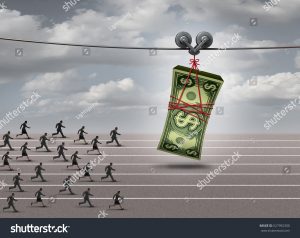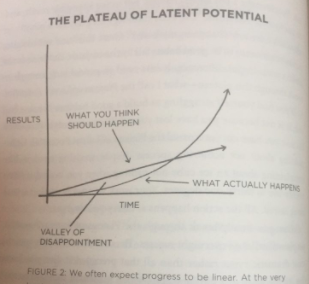Have you fallen for the sunk cost trap? The tendency to expend more energy in a certain direction, or in a certain activity, simply because you’ve already invested so much time in it? Even when a certain activity doesn’t meet your expectations; it becomes more difficult to stop and change direction, the more time and energy or investment you have given an action previously.

Sunk Cost Trap Examples – Cinema Ticket
Here’s some sunk cost trap, (also known as sunk cost fallacy) examples. A common example is that of paying for a cinema ticket and you aren’t enjoying the film. Rather than leave the cinema, you stay because, well you bought a ticket and it would be a waste of money if you left. But the choice is based on an assumption that you must stay because of the sunk cost of the ticket.
In actual fact, the lost time of sitting in a cinema watching a film you’re not enjoying may be actually costing you more in terms of lost time, which you’ll never get back! So for the cost of a cinema ticket you’ll waste 2 hours watching something you’re not enjoying!

Sunk Cost Fallacy Examples – A Restaurant
Another example is over eating at a restaurant. You’ve paid for the food but are full. So you cram the food in and eat every morsel, even though you’re no longer hungry. The thinking behind this decision is based on getting value for money from your food, which you’ve paid for. By leaving it, you assume you’re wasting money. But in reality, you’d be better off leaving the food left over once you’ve had enough. The food offers a diminishing value for every bite once you’re full!
Stuck In A Career/Job
A common experience for many people is to get trapped by a job or a career. Despite it not giving you the life and/or income you want, you continue doing something which makes you unhappy for decades. This is often because the diminishing returns of a career are not felt as they gradually come about. Over years in a career, you come to depend on your job and would lose income if you changed. So you stay because of the convenience. The longer you stay in a job, the harder it becomes to transition out of it.

Relationships
Relationships too can be good examples of the sunk cost trap too. The longer you are in a relationship for, the more difficult it is to get out. Even if people are unhappy in a relationship, they stay for convenience and because, well, “we’ve been together for years”. The fear of the unknown becomes part of the reasoning and the longer you sustain the status quo, the more invested in it you are – whether through an investment of time money or energy.
Sunk Cost & Your Self Image
You have invested your whole life in your own personal identity. But is it really you? Your self image is a massive part of how you interact with the world and what you believe about yourself. Is your self image serving you and are you a victim of the sunk cost trap in terms of investment you’ve made in to the “who” “you” think you are? Read more on this in Maxwell Matlz’s Psycho-cybernetics.
The Sunk Cost Trap & Me
I fell for the sunk cost trap too spending several years training to become a stunt performer. Although I enjoyed work when it happened most of the time I was struggling to make ends meet. I had to chase a number of jobs to fill in the many gaps between stunt contracts.

Despite this being a “dream job”, over the years it produced diminishing returns and I became disillusioned with the business. But being trapped by the “dream job” status and freedom which it afforded me, I struggled to either get more work or transition out of the career to something else offering the same kinds of benefits; freedom and passion.

I imagine this is the same for people within many careers. They can’t escape the “golden handcuffs” of their well paid career and they’ve no time to look for an alternative anyway. The longer their career lasts, the more they get paid and the more liabilities they acquire.
Even if they could find something, it would mean a massive loss of pay, change in status or a blow to the self image/self esteem. So instead of changing they become entrenched in their career all the more as time passes.
Sunk Cost Trap – Transitioning Into The Digital Economy
I juggled various jobs such as driving HGV’s and working in offices but dropped the work when the stunt jobs came in. This was massively exhausting and meant I never had much continuity in my income. I wanted something which I could pick up and drop and work at in my own time. So I looked into working online in some capacity. I initially started out with eBay and bought and sold from the site using a strategy I found in a ebook purchase.
But the Ebay business just tied me to my house and computer and I found myself getting more and more drawn in by it. I transitioned into affiliate marketing which is a business model which allows anyone to sell other people’s products online. Originally this was to use as a convenient business model to work around the stunt industry. But as I persevered, I realised it offered more potential to give me more time and financial freedom than the stunt work did!
Sunk Cost Trap – Online Business
If you think you’ve invested too much time in a certain direction and want to change things around, access a free video series and start learning how you can leverage the internet to create more choice and more freedom. Escape the sunk cost trap and make some new choices for a new life!
Learn more about building your own online business. Click on the image below to get started.

The Sunk Cost Trap And Affiliate Marketing
The sunk cost trap can also apply to affiliate marketing too. I definitely fell for the trap of doing too much of a particular strategy, trying to prove that it worked! Blogging, in particular can be a great strategy but takes a lot of time and effort to generate results. You don’t realise how much time it can take to actually break through what James Clear refers to as the valley of disappointment in his book Atomic Habits. This is the gap between what you think should happen and what actually happens. See image below.

If you’ve sunk a lot of time and energy into blogging, or consistently doing a certain activity online, it becomes more difficult to abandon that activity because of the sunk cost trap. But also, with an activity like blogging, you know that if you keep going, you’ll probably get some results from it. But you don’t know how long time might be for! Hence you can stay in this trap for a long period of time without acknowledging it and moving on to a better strategy!
I like blogging, and still write., hence this article. But I also acknowledged that others were doing better with other strategies. So I switched and now also am working on a YouTube paid marketing campaign alongside the blogging I do!